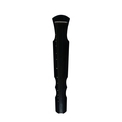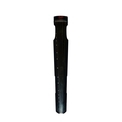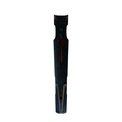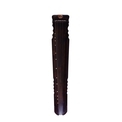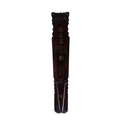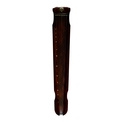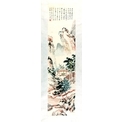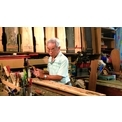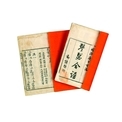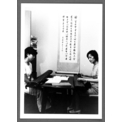Yinyinshi Qinpu (Yinyinshi Manuscript) - manuscripts (2)
The Yinyinshi Qinpu made use of traditional notations, and was written with a Chinese brush. The text is aligned vertically and is read from right to left. The inherited late Qing practice of marking the pitch and the rhythm next to the tablature is also apparent. The pitch is marked by gongchepu (the traditional gongche solfège notation) or the numbered musical notation in the margins, while the rhythm is marked by either dotted beats or the numbered musical notation. This picture shows the notation for the piece Yi Guren (Thinking of Old Friends).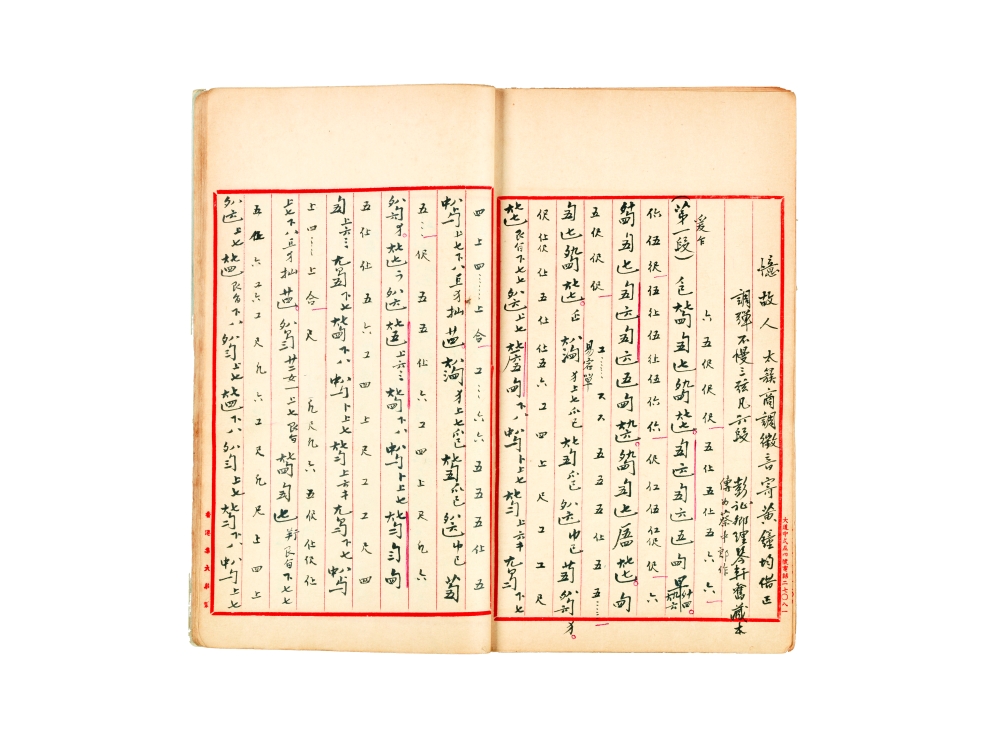
| Date | Late 1960s |
| People | Tsar, Teh-yun |
| Material Type | Image |
| Collection | The Legend of Silk and Wood: A Hong Kong Qin Story |
| Source | Courtesy of Sou Si-tai |
| Repository | Sou Si-tai |
| Note to Copyright | Permission for use in Hong Kong Memory is given by Sou Si-tai |
| Accession No. | lcs-hkqs-0041 |
Yinyinshi Qinpu (Yinyinshi Manuscript) - manuscripts (2)
The Yinyinshi Qinpu made use of traditional notations, and was written with a Chinese brush. The text is aligned vertically and is read from right to left. The inherited late Qing practice of marking the pitch and the rhythm next to the tablature is also apparent. The pitch is marked by gongchepu (the traditional gongche solfège notation) or the numbered musical notation in the margins, while the rhythm is marked by either dotted beats or the numbered musical notation. This picture shows the notation for the piece Yi Guren (Thinking of Old Friends).
| Date | Late 1960s |
| People | Tsar, Teh-yun |
| Material Type | Image |
| Collection | The Legend of Silk and Wood: A Hong Kong Qin Story |
| Source | Courtesy of Sou Si-tai |
| Repository | Sou Si-tai |
| Note to Copyright | Permission for use in Hong Kong Memory is given by Sou Si-tai |
| Accession No. | lcs-hkqs-0041 |
Yinyinshi Qinpu (Yinyinshi Manuscript) - manuscripts (2)
The Yinyinshi Qinpu made use of traditional notations, and was written with a Chinese brush. The text is aligned vertically and is read from right to left. The inherited late Qing practice of marking the pitch and the rhythm next to the tablature is also apparent. The pitch is marked by gongchepu (the traditional gongche solfège notation) or the numbered musical notation in the margins, while the rhythm is marked by either dotted beats or the numbered musical notation. This picture shows the notation for the piece Yi Guren (Thinking of Old Friends).
| Date | Late 1960s |
| People | Tsar, Teh-yun |
| Material Type | Image |
| Collection | The Legend of Silk and Wood: A Hong Kong Qin Story |
| Source | Courtesy of Sou Si-tai |
| Repository | Sou Si-tai |
| Note to Copyright | Permission for use in Hong Kong Memory is given by Sou Si-tai |
| Accession No. | lcs-hkqs-0041 |
Yinyinshi Qinpu (Yinyinshi Manuscript) - manuscripts (2)
The Yinyinshi Qinpu made use of traditional notations, and was written with a Chinese brush. The text is aligned vertically and is read from right to left. The inherited late Qing practice of marking the pitch and the rhythm next to the tablature is also apparent. The pitch is marked by gongchepu (the traditional gongche solfège notation) or the numbered musical notation in the margins, while the rhythm is marked by either dotted beats or the numbered musical notation. This picture shows the notation for the piece Yi Guren (Thinking of Old Friends).
| Date | Late 1960s |
| People | Tsar, Teh-yun |
| Material Type | Image |
| Collection | The Legend of Silk and Wood: A Hong Kong Qin Story |
| Source | Courtesy of Sou Si-tai |
| Repository | Sou Si-tai |
| Note to Copyright | Permission for use in Hong Kong Memory is given by Sou Si-tai |
| Accession No. | lcs-hkqs-0041 |
Yinyinshi Qinpu (Yinyinshi Manuscript) - manuscripts (2)
The Yinyinshi Qinpu made use of traditional notations, and was written with a Chinese brush. The text is aligned vertically and is read from right to left. The inherited late Qing practice of marking the pitch and the rhythm next to the tablature is also apparent. The pitch is marked by gongchepu (the traditional gongche solfège notation) or the numbered musical notation in the margins, while the rhythm is marked by either dotted beats or the numbered musical notation. This picture shows the notation for the piece Yi Guren (Thinking of Old Friends).
| Date | Late 1960s |
| People | Tsar, Teh-yun |
| Material Type | Image |
| Collection | The Legend of Silk and Wood: A Hong Kong Qin Story |
| Source | Courtesy of Sou Si-tai |
| Repository | Sou Si-tai |
| Note to Copyright | Permission for use in Hong Kong Memory is given by Sou Si-tai |
| Accession No. | lcs-hkqs-0041 |
Yinyinshi Qinpu (Yinyinshi Manuscript) - manuscripts (2)
The Yinyinshi Qinpu made use of traditional notations, and was written with a Chinese brush. The text is aligned vertically and is read from right to left. The inherited late Qing practice of marking the pitch and the rhythm next to the tablature is also apparent. The pitch is marked by gongchepu (the traditional gongche solfège notation) or the numbered musical notation in the margins, while the rhythm is marked by either dotted beats or the numbered musical notation. This picture shows the notation for the piece Yi Guren (Thinking of Old Friends).
| Date | Late 1960s |
| People | Tsar, Teh-yun |
| Material Type | Image |
| Collection | The Legend of Silk and Wood: A Hong Kong Qin Story |
| Source | Courtesy of Sou Si-tai |
| Repository | Sou Si-tai |
| Note to Copyright | Permission for use in Hong Kong Memory is given by Sou Si-tai |
| Accession No. | lcs-hkqs-0041 |
Yinyinshi Qinpu (Yinyinshi Manuscript) - manuscripts (2)
The Yinyinshi Qinpu made use of traditional notations, and was written with a Chinese brush. The text is aligned vertically and is read from right to left. The inherited late Qing practice of marking the pitch and the rhythm next to the tablature is also apparent. The pitch is marked by gongchepu (the traditional gongche solfège notation) or the numbered musical notation in the margins, while the rhythm is marked by either dotted beats or the numbered musical notation. This picture shows the notation for the piece Yi Guren (Thinking of Old Friends).
| Date | Late 1960s |
| People | Tsar, Teh-yun |
| Material Type | Image |
| Collection | The Legend of Silk and Wood: A Hong Kong Qin Story |
| Source | Courtesy of Sou Si-tai |
| Repository | Sou Si-tai |
| Note to Copyright | Permission for use in Hong Kong Memory is given by Sou Si-tai |
| Accession No. | lcs-hkqs-0041 |
Yinyinshi Qinpu (Yinyinshi Manuscript) - manuscripts (2)
The Yinyinshi Qinpu made use of traditional notations, and was written with a Chinese brush. The text is aligned vertically and is read from right to left. The inherited late Qing practice of marking the pitch and the rhythm next to the tablature is also apparent. The pitch is marked by gongchepu (the traditional gongche solfège notation) or the numbered musical notation in the margins, while the rhythm is marked by either dotted beats or the numbered musical notation. This picture shows the notation for the piece Yi Guren (Thinking of Old Friends).
| Date of Death | Late 1960s |
| People | Tsar, Teh-yun |
| Material Type | Image |
| Collection | The Legend of Silk and Wood: A Hong Kong Qin Story |
| Source | Courtesy of Sou Si-tai |
| Repository | Sou Si-tai |
| Note to Copyright | Permission for use in Hong Kong Memory is given by Sou Si-tai |
| Accession No. | lcs-hkqs-0041 |
Yinyinshi Qinpu (Yinyinshi Manuscript) - manuscripts (2)
The Yinyinshi Qinpu made use of traditional notations, and was written with a Chinese brush. The text is aligned vertically and is read from right to left. The inherited late Qing practice of marking the pitch and the rhythm next to the tablature is also apparent. The pitch is marked by gongchepu (the traditional gongche solfège notation) or the numbered musical notation in the margins, while the rhythm is marked by either dotted beats or the numbered musical notation. This picture shows the notation for the piece Yi Guren (Thinking of Old Friends).
| Date | Late 1960s |
| Material Type | Image |
| Collection | The Legend of Silk and Wood: A Hong Kong Qin Story |
| Source | Courtesy of Sou Si-tai |
| Note to Copyright | Permission for use in Hong Kong Memory is given by Sou Si-tai |
| Accession No. | lcs-hkqs-0041 |
Yinyinshi Qinpu (Yinyinshi Manuscript) - manuscripts (2)
The Yinyinshi Qinpu made use of traditional notations, and was written with a Chinese brush. The text is aligned vertically and is read from right to left. The inherited late Qing practice of marking the pitch and the rhythm next to the tablature is also apparent. The pitch is marked by gongchepu (the traditional gongche solfège notation) or the numbered musical notation in the margins, while the rhythm is marked by either dotted beats or the numbered musical notation. This picture shows the notation for the piece Yi Guren (Thinking of Old Friends).
| Date | Late 1960s |
| Material Type | Image |
| People | Tsar, Teh-yun |
| Collection | The Legend of Silk and Wood: A Hong Kong Qin Story |
| Source | Courtesy of Sou Si-tai |
| Repository | Sou Si-tai |
| Note to Copyright | Permission for use in Hong Kong Memory is given by Sou Si-tai |
| Accession No. | lcs-hkqs-0041 |
Copyright © 2012 Hong Kong Memory


